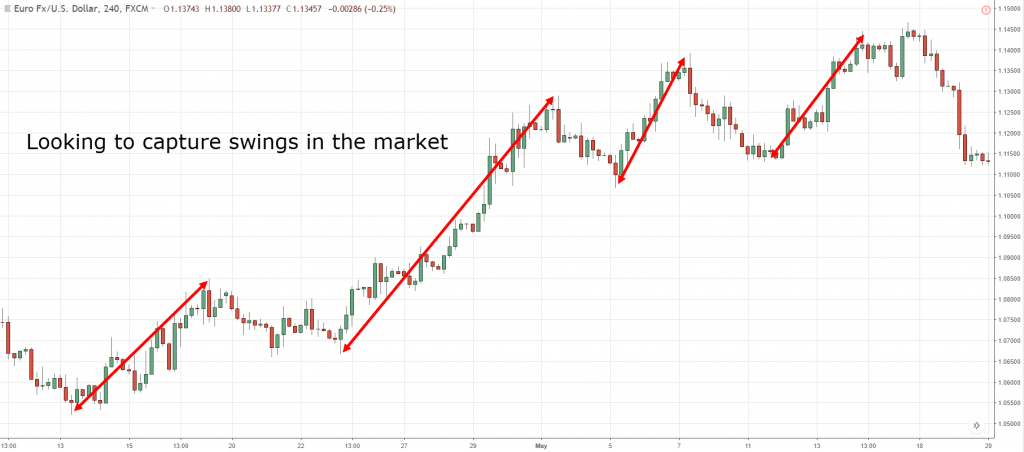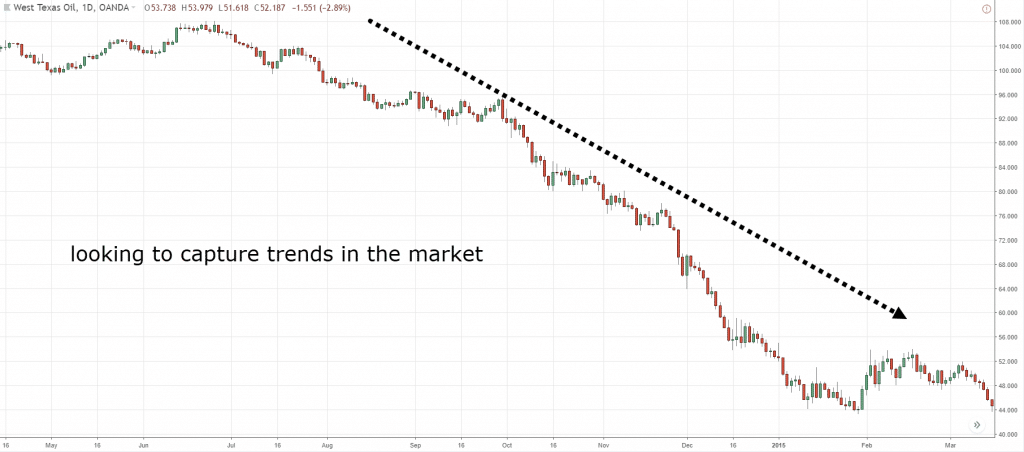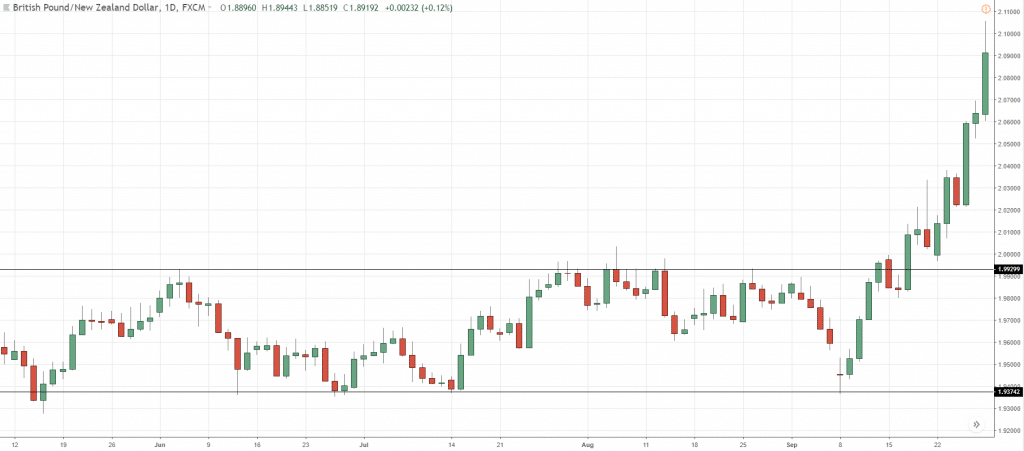You’ve been told day trading is easy.
Make 10 pips a day, and in a month, you’re up 200 pips.
On a standard lot, that’s equivalent to $2000.
Now you ask yourself:
“Can day trading be a full time job?”
But here’s the truth…
1. The above statement is misleading as it doesn’t take into account losses.
2. If you have a full-time job, day trading is not encouraged.
Why?
Transaction cost is a killer
A large part of your success as a trader depends on your transaction cost.
Imagine:
You’re a retail Forex trader with a $50,000 account.
You pay an average spread of 2 pips, which amounts to $20 per lot.
If you trade an average of 100 lots a month, your transaction cost is $2000!
Think about this..
You need to make 4% a month just to break even.
From a yearly standpoint, you need to make 48% a year just to break even.
Compare that with a professional futures trader, who pays commission averaging $2 per lot.
Trading an average of 100 lots a month, transaction cost is $200, or 0.25% a month.
As a retail trader, you’re paying 10 times more in transaction costs.
Day trading requires you to trade multiple times a day. This leads to higher transaction cost which erodes your edge in the markets.
And I’ve yet to mention brokers increasing their bid/ask spread during major news releases…
More stress on you
Day trading requires you to devote lots of attention to the markets, especially if you’re day trading with full time job.
You’ve seconds to make trading decisions like:
- Where will I enter?
- Where will I exit if I’m wrong?
- Where will I exit if I’m right?
- Do I take partial profits?
- How much risk do I put on?
- How do I manage this trade?
- Are there major news release coming up?
You’re making all these decisions on the fly.
If you hesitate too long, you could miss a trading opportunity.
But does the stress comes from trading only?
I doubt so.
Here’s why:
If you have a full-time job, you’d bring work-related stress to your day trading endeavor.
So, what makes you think can you day trade with a full time job?
And for those with family and kids to attend to…
Would you want to risk your trading capital while putting your kids to sleep?
Forget social life
Imagine this:
You work from 8 to 6 every day.
You head home and eat your dinner.
Then you open your trading platform and trade till the wee hours before going to bed.
The next day you wake up, and rinse repeat all over again, from Monday to Friday.
Slowly, you start to neglect your family, friends and loved ones.
Is this what you want?
I wouldn’t wish that on you.
You’ve worked hard at your day job, and when you get home, you’re a slave to the markets.
It could be a consolation if you’re consistently profitable.
But what if you’re consistently losing every night?
You lose your family, friends, loved ones, and your hard-earned money. A horrible risk to reward if you ask me.
However, if you don’t mind the stress and not having a social life, transaction cost is still a major issue.
My suggestion would be to get a job in proprietary trading or lease a seat in a trading arcade. You’d lower transaction costs and also have interaction with other traders.
This way, it’s more feasible to day trade with full time job, because it IS your full-time job!
But what if you don’t want that?
Trade the higher time frame
Now:
You know day trading is not as glamorous as it seems.
You incur insane transaction costs which erode your trading edge.
Not forgetting the increase in stress and lack of social life.
But what if you still want to be a trader?
Then consider trading the higher time frame.
Advantages of trading the higher time frame and why you should not day trade:
1. You will have lower transaction cost as your trading frequency is reduced.
2. Your transaction cost have little impact on your risk to reward ratio.
3. You’d be less stressful as you do not need to constantly monitor the markets.
4. You have more time for the important things that matter like family, friends and loved ones.
To understand the pros and cons further, go read Day Trading VS Trend Following, Which is Better?
Now…
If you have decided to trade the higher time frame, there are a few ways you can go about it.
You can choose to be a swing trader or position trader.
Swing trader
For swing trader, you are looking to capture swings in the market.
You will have:
- Smoother equity curve as your profit target is simply one swing in the market
- Winning rate varying from 40-50%
- Trades lasting from days to weeks
Position trader
For position trader, you are looking to capture trends in the market.
You will have:
- More volatile equity curve as you watch profits turn into losses, in hope that you will catch a trend
- Winning rate varying from 30-40%
- Trades lasting from weeks to months
You may wonder:
Can I be both?
Yes. In fact, you can incorporate both trading styles.
You can capture a swing in the market and take half your position off.
Then let the remaining half ride the long-term trend.
Frequently asked questions
#1: How can I get started on trading the higher time frame?
You can start by trading off the daily timeframe. It has many “hidden” benefits, especially if you have a full-time job. You can find out more about it here.
#2: Isn’t day-trading just as stressful as any other job out there?
Yes it could be. But couple that with the stress from your full-time job, family and kids, you’re likely to worsen your trading psychology and make bad trading decisions more easily.
Conclusion
Day trading is something I do not encourage if you currently have a full-time job.
You will add more stress to yourself, lose your social life and incur higher transaction costs.
Instead, you can adopt a higher time frame perspective, and look to be a swing or position trader.
It comes with less stress, better work-life balance, and transaction cost is almost negligible.
What are your thoughts on day trading with a full-time job?
Do you want to learn a new trading strategy that allows you to profit in bull and bear markets?
In my FREE trading course (valued at $48), I will teach you this powerful trading strategy step by step, along with charts and examples.
You can download it here for FREE.







It is the best and most meaningful and helpful for me to be you!
Finally, I am seeking to your course,Rayner.Thank you!;-)
Hi Vlada,
Thanks for stopping by.
Really glad to know it helps you 🙂
Rayner
Hi Rayner,
In the last pic and the rest of the pictures, how do you determine the reversal?
Hope to had wrote an article on it, if so, what should the link be?
I’ve been watching your videos lately, may I know which platform are you using and trading brokerage house? Any reasons they’re better?
Thanks 🙂
Hi Wong,
You can check out this post https://www.tradingwithrayner.com/how-to-identify-trend-reversal/
I use MT4 for my charts.
For brokers I don’t wish to mention in a public domain because these days anything can happen to brokers and i don’t want to be responsible should anything ‘bad’ happens.
Rayner
Absolutely spot on
Thanks Nik!
Loving your articles Rayner. I lowered my trading to about 6-8 trades a year a long time ago for all those reasons that you posted. I started off trading a lot and almost destroyed my account doing so. Now i get to wait for the trade to come to me, take only the ones that meet my criteria and sleep well at night.
Keep up the great work!
Hi Peter,
Thank you for your kind words.
Wow 6 – 8 trades a year seems quite little from a trading standpoint.
I’m assuming you would hold positions for months or even years?
Rayner
Excellent article Rayner. I have a full time job and to me this is the only way to trade for now anyway.
Thanks Roy, cheers.